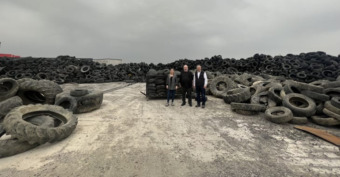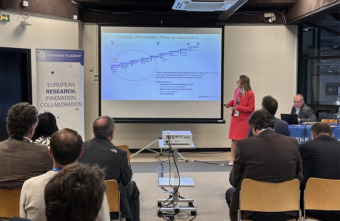In Turkey, Nanografen, a nanotechnology R&D company, and a Graphene Flagship partner is piloting graphene production from ‘end-of-life tyres’ (ELT) with the goal of improving recycling systems and ultimately making automotive vehicles more eco-friendly by incorporating graphene-reinforced auto parts.
Graphene is an allotrope of carbon consisting of a single layer of atoms arranged in a hexagonal lattice nanostructure and is currently the world’s thinnest two-dimensional material.
It has become a valuable and useful nanomaterial thanks to its exceptionally high tensile strength, electrical conductivity, and transparency.
Waste to value
‘End-of-life tyres’ (ELT) on the other hand are one of the world’s most problematic sources of waste due to their large volume and the fact that they also contain a range of environmentally hazardous components.

Nanografen’s repurposing of ELT creates a market opportunity by the conversion of waste tyres to recycled carbon black, to graphene, leading to possibilities for graphene to become an impactful part of the thermoplastic composites market.
Thermoplastic composites are used across all sorts of industries, including aerospace, textiles, automotive, construction, energy storage, renewable energy, and flame retardants.
By producing graphene in this way, Nanografen lowers the cost of graphene. Using ELT as a starting material – and recycling- and upcycling for mass production in the plastics industry – is cheaper than many other forms of graphene production.
ELT-derived graphene-reinforced components
The company has already begun developing prototypes for graphene-reinforced lightweight automotive parts, for use in electric vehicles (EVs).

For example, Nanografen – in partnership with compounder Ravago Group – is now an official supplier of Renault: their graphene-reinforced front-end carrier part has been validated by Renault for use in some of their vehicles.
Graphene-reinforced lightweight automotive parts mark an exciting development for the automotive industry.
These parts are cost-effective and also lightweight enough that they help reduce vehicular weight overall, thereby reducing the amount of energy needed to power the vehicle.
In this sense, the use of ELT-derived graphene-reinforced components in the vehicles makes these vehicles more eco-friendly.
Other Nanografen-based products under commercialisation include a graphene-reinforced recycled washing machine pulley and graphene-reinforced flexible polyurethane foams for sound insulation.
Facts
About the Graphene Flagship
Funded by the European Commission in 2013, the Graphene Flagship celebrates a decade of 2D materials innovation and has brought graphene innovation out of the lab and into commercial applications.
Bringing diverse competencies from nearly 170 academic and industrial partners in 22 countries together, the Graphene Flagship facilitates cooperation between its partners, accelerating the timeline for industry acceptance of graphene technologies.
With applications in everything from energy and transportation to electronics and biomedicine, graphene and other 2D materials are changing the way we live and work. The European Commission’s FET Flagships enable research projects on an unprecedented scale.
With EUR 1 billion budgets, the Graphene Flagship, Human Brain Project, and Quantum Flagship serve as technology accelerators, helping Europe to compete with other global markets in research and innovation.
With an additional EUR 20 million investment, the European Commission has now funded the creation of an experimental pilot line for graphene-based electronics, optoelectronics, and sensors.



